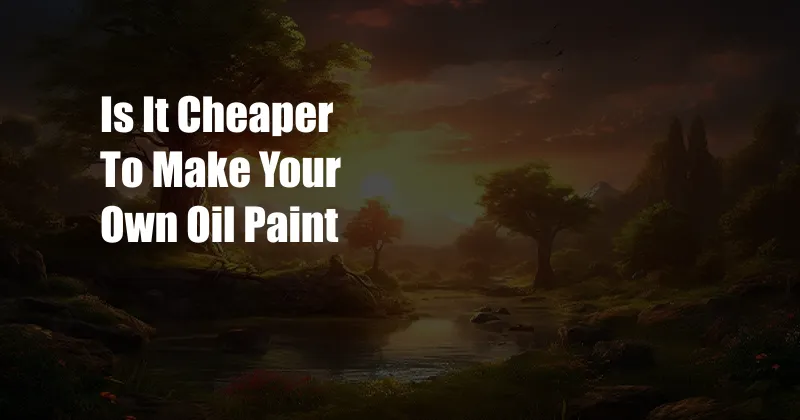
Is It Cheaper to Make Your Own Oil Paint?
In this era of DIY and sustainability, the question of whether making your own oil paints is more cost-effective has emerged. As an avid artist and a passionate advocate for exploring cost-saving alternatives, I embarked on a personal journey to unravel the intricacies of oil paint making.
My initial experience with store-bought oil paints left me with a sense of unease. The escalating prices and the environmental concerns associated with pre-packaged paints fueled my desire to find a more sustainable and economical solution. Armed with curiosity and a desire to experiment, I delved into the world of DIY oil paint making.
Making Your Own Oil Paint: A Journey of Discovery
The Definition and History of Oil Paints
Oil paints consist of three primary components: pigments, a drying oil, and a thinner or solvent. Pigments are finely ground solids that provide color and opacity to the paint. Drying oils, such as linseed oil or poppyseed oil, are polymerized fats that bind the pigments together and contribute to the paint’s drying time. Thinner allows for the adjustment of paint consistency and viscosity.
Oil painting traces its lineage back to the early 15th century, where Flemish painters embraced its versatility and rich color palette. Its enduring appeal has remained strong throughout art history, captivating artists with its ability to capture light and texture.
The Costs and Benefits of DIY Oil Paint
The cost comparison between DIY and commercial oil paints is a crucial consideration for any artist. While the initial investment in materials for DIY paint may seem higher, the long-term savings can be substantial. The cost of pigments and oil varies depending on the quality and quantity, but generally, creating your own oil paint can result in significant savings compared to purchasing pre-packaged paints.
Apart from financial benefits, making your own oil paint offers a unique opportunity for customization. Artists gain complete control over the selection of pigments and oils, allowing them to tailor their paints to specific requirements. Additionally, DIY oil paint is typically free of additives and preservatives, resulting in a purer and more environmentally friendly product.
The Latest Trends in Oil Paint Making
The art community is embracing the trend of DIY oil painting with enthusiasm. Online forums and social media platforms are brimming with information, tips, and discussions on every aspect of the process. This collaborative environment empowers artists with a wealth of knowledge and support.
Recent years have witnessed advancements in pigment technology, offering a more vibrant and diverse range of colors for DIY paint makers. Similarly, the development of new drying oils has expanded the possibilities for creating paints with variable drying times and textures.
Tips and Expert Advice for Making Your Own Oil Paint
Embarking on the journey of making your own oil paints requires careful planning and meticulous execution. Here are some invaluable tips to ensure success:
- Choose high-quality materials: The quality of your pigments and oil will directly impact the outcome of your paint. Invest in reputable suppliers and thoroughly research different options.
- Experiment with different ratios: The ratio of pigment to oil affects the paint’s consistency, drying time, and opacity. Start with a basic recipe and adjust it based on your preferences.
- Test your paints thoroughly: Before committing to large-scale production, test your paints on small canvases or surfaces to assess their characteristics.
- Keep your workspace clean and organized: A clean workspace helps prevent contamination and accidents. Ensure proper ventilation and use protective gear when handling pigments and chemicals.
- Seek guidance from experienced artists: Connect with other DIY paint makers or join online communities to learn from those who have mastered the craft.
Addressing Common FAQs on DIY Oil Paint
- Is it difficult to make oil paint? With proper preparation and attention to detail, making oil paint can be a rewarding experience. The complexity of the process depends on the specific materials and techniques you choose.
- How long does it take to make oil paint? The time required for DIY oil paint making varies depending on the scale of production and the methods used. Allow ample time for research, experimentation, and the actual paint-making process.
- Can I use DIY oil paint immediately? It is recommended to allow DIY oil paint to cure for a period of time before use. This curing process allows the paint to fully develop its properties and achieve optimum performance.
- How should I store DIY oil paint? Store DIY oil paint in airtight containers, away from light and extreme temperatures, to preserve its quality.
Conclusion
Making your own oil paints can be a cost-effective, sustainable, and fulfilling endeavor for artists seeking greater control over their materials. While the initial investment may be higher than purchasing pre-packaged paints, the long-term savings and the creative satisfaction of creating your own unique artistic tools can be invaluable. Embrace the world of DIY oil paint making and unleash your inner artist.
Would you like to explore the topic of making your own oil paints further? Share your thoughts and questions in the comments section below.